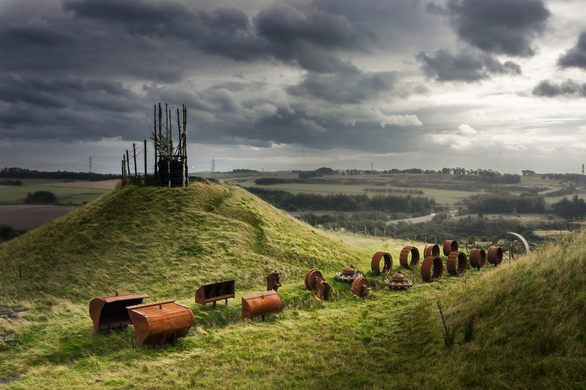In the heart of Fife lies the remnants of St. Ninians, a coal mine that once fueled Scotland’s industrial growth. This area, renowned for its rich history of coal mining, saw deep-level and open-cast mining methods extract coal from the earth for decades, leaving a profound impact on the landscape. The mine, which operated into the 21st century, ultimately consumed the village of Lassodie—a place where a young Sean Connery was said to have visited frequently after his grandparents retired there in the 1930s.

When mining operations ceased, the land was left scarred, and thoughts turned to how to rehabilitate this once-vibrant area. The task of reimagining St. Ninians fell to Charles Jencks, an American artist and cultural theorist known for his large-scale landscape projects throughout Scotland. Jencks envisioned transforming the 930-acre site into a monumental landform artwork—the largest in Scotland—that would symbolize a journey across four continents, reflecting the global influence of Scottish emigration.

The plan was to create geometric mounds surrounding a representation of Scotland, each symbolizing regions most influenced by the Scots. However, financial difficulties led to a dramatic scaling back of the project. The owner, Scottish Coal, went bankrupt in 2013, halting further development. What remains is a stark, eerie landscape, marked by unfinished mounds and earthworks that offer a glimpse into the grand vision that once was.

Today, the site stands as a fascinating blend of industrial history and artistic ambition. While much of Jencks’ vision was never realized, visitors can still explore the remnants of the project. The Europe mound, with its three prominent barbed mounds and a stone map, stands as a testament to the scale of the original plan. The North America mound, though less defined, also invites exploration.

Know Before You Go Visitors to St. Ninians should be prepared for a rugged experience. The site is free to access and popular with dog walkers, though parking is limited. The best approach is from Kingseat, a nearby village, with a 30-minute walk along the Fife Pilgrim Way footpath. The path offers stunning views, especially as you cross the causeway of Loch Fitty with the mounds of St. Ninians rising ahead. The terrain can be steep, so sturdy footwear is recommended, particularly in wet weather. For those interested in the area’s mining history, Kingseat Community Centre provides additional information and free parking.

